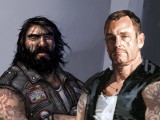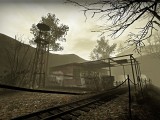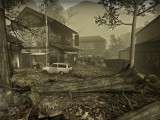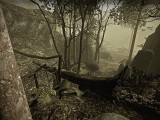Source level designer Mark Edwards is currently making a bit of a splash in the Left 4 Dead customization community with his promising work-in-progress custom campaign, Yama, refreshingly set in the country of Japan. Though L4Mods currently rules Yama content with an iron fist, Edwards nevertheless graciously took the time to answer our questions.
Edwards, fresh off releasing a custom survival map, Dead Meat (his portfolio additionally includes a contest-winning level for the Steamworked Zombie Panic: Source) is no stranger to gaming horror, and while we explicitly wanted to hear his feelings on the more technical intricacies and design-related dilemmas present in developing Left 4 Dead content, Edwards also touches on broader conceptual decisions, issues and themes that are present in the horror genre, relating his vision to titles such as Silent Hill and Siren: Blood Curse.
We would like to thank Edwards for answering our questions, and for those with a keen eye, there are Yama and Dead Meat screenshots sprinkled amidst the answers after the jump! Dead Meat can be acquired from http://www.scorchingcraniums.com/portfolio/abattoir.html.
How different would you consider the requirements, design-wise, for working on a L4D level compared to your earlier projects for, say, Zombie Panic: Source?
Design-wise it’s not that different, you block out the map, test with a small group of people and keep going until the gameplay works. The obvious difference is that L4D relies on AI, so you need to design the map with that in mind, and also remember that replayability is probably the most important thing in this game, so you need to give the player enough options to keep them interested time after time, or let them try a different tactic if they die and have to keep playing the same part over and over. It might need a bit more thought than a map for a game like CSS, but with enough beta testing you can solve all those problems.
There is, in my own experience, considerable variation with the difficulty level of Valve’s own survival maps. How importantly did playtesting figure for Dead Meat?
I’m registered on a couple of forums full of other talented mappers so I never have a problem getting feedback. With Dead Meat, I released a couple of beta versions on those forums to get feedback on how it played out before releasing a public version. I’ve also got a few friends who play the game so I test with them.
The good thing about Left 4 Dead is that it is very AI-centric: Although it doesn’t tell you everything about the map, I can just create a nav mesh and run through it with bots on my own. So usually I get to test the map in all the different ways it can be played. Once the level is public, and everyone has a chance to play, you’re bound to find the last few bugs that were missed.
Different people told me it was either too easy or too hard, but playing and testing I think I found a good balance. While some locations might be easy to defend, the layout usually forces you to move and whenever I play it I end up moving from room to room so the difficulty changes in a single playthrough.
Dead Meat is a professional entry to mapping for Left 4 Dead. What was your primary motivation for approaching the admittedly arduous and intimidating task of developing a full campaign in the form of Yama, instead of, say, another survival-based level?
I actually started Yama in 2006 when Turtle Rock announced the game. They ended up delaying it until 2008 but I worked on it over that time, mostly just making prefabs, textures, models etc, and getting more and more references. The setting and map order has actually changed since then, and I don’t think I knew as much back then how much work a 5-map campaign would actually be.
Dead Meat started out from some photos in my Yama references folder of an abandoned abattoir which I knew wouldn’t make the campaign, and that map was more or less a test to get used to working with the L4D content and the director, I think it only took about 6 weeks from start to finish. One of the problems with making a campaign is coming up with a consistent, realistic theme that can span 5 maps and anything up to 90 minutes of gameplay.
I don’t have any concrete ideas for another campaign mostly because of that. I do have another survival map planned, and even though a lot of people don’t like survival, the maps are far easier and quicker to make. Since I enjoy mapping even if no one plays them, that’s what I’ll be doing next.
The choice of utilizing Japan as a setting seems enviably obvious in retrospect, with a thriving tradition of survival horror in Japanese popular cinema and gaming. Would you say such geography is underutilized in game design overall?
I’m not sure if the setting itself is that important; Silent Hill is one of my favourite games series but that was more for the style of horror they used. There were a lot of unique things in that game but as it was set in the United States, I think that’s an unique trait of Japanese developers.
I prefer horror in games like in Siren or in movies like Audition but I think that’s more to do with the creators than the setting. When it comes to films I think that’s down to studio pressure and appealing to the lowest denominator in Hollywood, so I don’t think it’s the setting really, it’s just that the developers that tend to set their games in Japan are Japanese, and they happen to be better at creating horror.
The attention to minute detail, already visible in screenshots of Yama, is terrific. How much of your actual “mapping time” goes into researching textures and props?
Far more time than I should spend. When I get references I usually go overboard and find too many things I want to include. The first map in the campaign was going to be the same mountain setting as the others, but somehow I ended up switching it to Tokyo itself which means I now need dozens more textures and models. I’ve got photos of places I want to include and I sometimes change the map to work them in, but having so many photos means I get a good idea of the setting and as you mentioned, the kind of textures or models I could use elsewhere in the map.
Originally I had some photos of a cable car station, and looking for more photos of that place led me to other places that became maps in the campaign, like a hotel in the 5th level of the campaign. Even if I don’t end up using all my references, they give me a good idea of the look of a particular place and its architecture.
For me, the photographic hues together with the decay do vividly recall Japanese war photography from before and after World War II. Is this a source of inspiration for you?
That wasn’t a direct inspiration. I do think that like in a lot of other horror games, taking a recognisable environment and twisting it is a really good way of making a player feel uneasy. This is something that will work on every playthrough unlike, say, a tank bursting through a wall.
Siren: Blood Curse was a big inspiration for the village level and maybe Japan Studio (SCEJ) were inspired by war photography, but I thought the sepia tint works well for this map because after playing through the more colourful Tokyo and temple levels and then riding the cable car into a brown, desaturated, almost silent village, it gives that feeling of something not being right.
In relation to my previous question, I do feel that we are all accustomed (and even programmed) to seeing something inherently fearful and horrific about the destruction of Japan, with Hiroshima and Nagasaki still in recent memory. I’m definitely chilled by the screenshots, and the location seems ideal for survival horror. Dead Meat, however, does contain overtones of macabre humour as well. Do you think humour is essential for survival horror?
Going back to Silent Hill, I think Silent Hill 3 did this well with some of its characters and dialogue. I don’t think it’s essential but done in the right way it can be effective. Like how the horror itself is often subtle in those games, then subtle humour can work in the same way.














Share